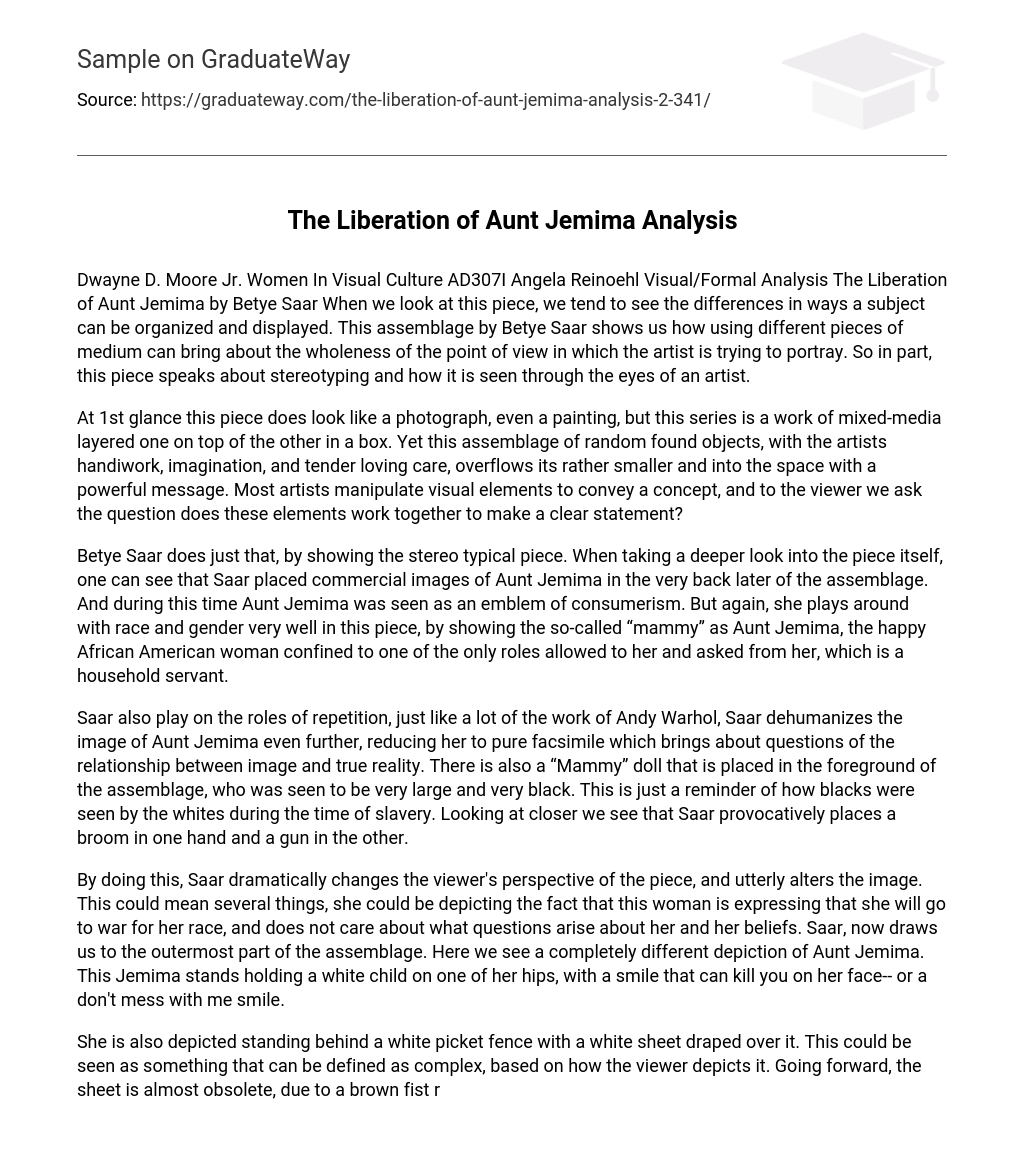Dwayne D. Moore Jr. Women In Visual Culture AD307I Angela Reinoehl Visual/Formal Analysis The Liberation of Aunt Jemima by Betye Saar When we look at this piece, we tend to see the differences in ways a subject can be organized and displayed. This assemblage by Betye Saar shows us how using different pieces of medium can bring about the wholeness of the point of view in which the artist is trying to portray. So in part, this piece speaks about stereotyping and how it is seen through the eyes of an artist.
At 1st glance this piece does look like a photograph, even a painting, but this series is a work of mixed-media layered one on top of the other in a box. Yet this assemblage of random found objects, with the artists handiwork, imagination, and tender loving care, overflows its rather smaller and into the space with a powerful message. Most artists manipulate visual elements to convey a concept, and to the viewer we ask the question does these elements work together to make a clear statement?
Betye Saar does just that, by showing the stereo typical piece. When taking a deeper look into the piece itself, one can see that Saar placed commercial images of Aunt Jemima in the very back later of the assemblage. And during this time Aunt Jemima was seen as an emblem of consumerism. But again, she plays around with race and gender very well in this piece, by showing the so-called “mammy” as Aunt Jemima, the happy African American woman confined to one of the only roles allowed to her and asked from her, which is a household servant.
Saar also play on the roles of repetition, just like a lot of the work of Andy Warhol, Saar dehumanizes the image of Aunt Jemima even further, reducing her to pure facsimile which brings about questions of the relationship between image and true reality. There is also a “Mammy” doll that is placed in the foreground of the assemblage, who was seen to be very large and very black. This is just a reminder of how blacks were seen by the whites during the time of slavery. Looking at closer we see that Saar provocatively places a broom in one hand and a gun in the other.
By doing this, Saar dramatically changes the viewer’s perspective of the piece, and utterly alters the image. This could mean several things, she could be depicting the fact that this woman is expressing that she will go to war for her race, and does not care about what questions arise about her and her beliefs. Saar, now draws us to the outermost part of the assemblage. Here we see a completely different depiction of Aunt Jemima. This Jemima stands holding a white child on one of her hips, with a smile that can kill you on her face– or a don’t mess with me smile.
She is also depicted standing behind a white picket fence with a white sheet draped over it. This could be seen as something that can be defined as complex, based on how the viewer depicts it. Going forward, the sheet is almost obsolete, due to a brown fist raised in the black power salute. This gives us a sense that Aunt Jemima is transformed from a negative stereotype, to an independent, assertive, strong individual human being. Saar has given us the sense that she has seized control of this piece to define identity. She is also holstering this pistol, which also shows the viewer that she will fight for what she believes in.
As a “Mammy” it’s seen by the white population that she has nothing worth fighting for, but as we can see, the white child she is bearing helps ease the role of Motherhood and Nurturer. She takes it a step further by giving everyone ample time to search deep within themselves and understand, no matter what life throws your way, we are all human and individuals, and there is nothing that should ever make you feel as though you are not. In Conclusion, Saar has demonstrated the dadaists’ belief that conceptual level, art happened and be defined.
She does a really good job at how images constructed well, can take on the perspective of what we perceive as a reality. This is a very profound piece, and as the viewer, we have to open our minds and our hearts to view it. We cannot see it or view it without confronting our own values and our own morality, and that can be whether one is a black female, or white male of European descent. The liberation of Aunt Jemima by Saar, gives us a sense of how time, patience, morality, and understanding can help to bring together this piece in our minds.





